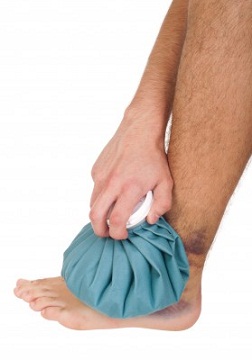As enjoyable as running may be in your life, if you suffer from ankle sprains it can become a painful experience.
Your ankles have a very important job. They are to connect your foot to your lower leg and allow your foot to turn and bend during movement. Without your ankles, you would not be able to walk up and down stairs or go out for your runs.
Keep reading to educate yourself about this injury and to learn how you can protect your ankles from sprains.
Ankle Sprains Explained

The ankle is a joint which is surrounded by supporting ligaments. This is the structure that allows your foot to twist and turn as needed during a run, but it is not designed to bend or move at all angles.
When your foot lands at an unnatural angle and your body weight comes down on top of it, the tension can cause those ligaments around the ankle joint to twist, pull or even tear. This is when you experience the pain most people associate with ankle sprains.
When you sprain an ankle, you may feel your foot turn sideways or you may feel the unnatural angle or ache of the foot.
There may also be some type of pop or other sensation in the area of your ankle.
Swelling often comes on rather quickly after the ankle is sprained. This can happen just walking down the street or when hiking, but it is also a very common injury for runners.
There are three grades of recognized ankle sprains, with grade three being the more serious medical condition. Grade one is a minor tear in the ligament while grade three is a complete severance of the ligament.
Common Causes
Anytime the foot rolls a little in one direction and then weight is placed down on the foot, the ankle can roll from that unnatural position and stretch those ligaments supporting the ankle joint. Think of the way your foot would be propped on the edge of a large rock while hiking. If too much weight comes straight down on the ankle while in that position, the ankle will roll to the side and an sprain will result.
If you sit down and look at your foot stretched out in front of you, you will notice that it is naturally designed to move up and down, with limited flex from side to side. If this natural range of motion is compromised with weight coming down on the ankle, ankle sprains can be the result.
Treatment Options
It is important to get off your ankle as quickly as possible after experiencing a sprain. If you are out on a run, try to call someone to pick you up if you are too far to turn back and walk on your own. Put ice on the injury and then wrap it up very tight. The goal is to compress the ankle to prevent future swelling.
Stay off of the foot for at least a day, continuing to treat the injury to reduce swelling. Ice the injury for ten or fifteen minutes every couple hours during the day immediately following the sprain. Keep your foot propped up to further control swelling.
If you cannot put some weight down on the ankle after a couple days, head in to the doctor to rule out more substantial injuries. You may need to avoid placing full weight down on the foot for a few days after the sprain, but you do want to gradually start placing some weigh down on the foot. If you are unable to walk around again after a week or two, it is a good idea to get a medical evaluation.
How to Prevent
Some athletes are now wearing light braces on their ankles to help prevent ankle sprains, but this is no guarantee that a sprain will not occur. You can limit your chances of a sprain by running on straight, flat terrain, where your feet do not fall on many rocks and uneven surfaces. Yet, there are still cracks and uneven patches in tracks that can cause the foot to land at an unnatural angle.
The best thing you can do to prevent ankle sprains is to strengthen your calves and ankles through toe raises and other simple exercises. Making sure you run with proper form and control your feet as you go through uneven terrain may also help you avoid this running injury.
Do you want to get more tips on how to prevent and cope with running injuries? You should give Running Doc’s Guide to Healthy Running, written by Lewis Maharam, definitely a try!
Recommended further reading:
- How to prevent achilles tendonitis
- How to prevent blisters
- How to prevent DOMS
- How to prevent hamstring injuries
- How to prevent muscle cramps
- How to prevent overtraining syndrome
- How to prevent plantar fasciitis
- How to prevent shin splints
- How to prevent stress fractures
Return from Ankle Sprains to Running Injuries
Return to Marathon Training Tips home
